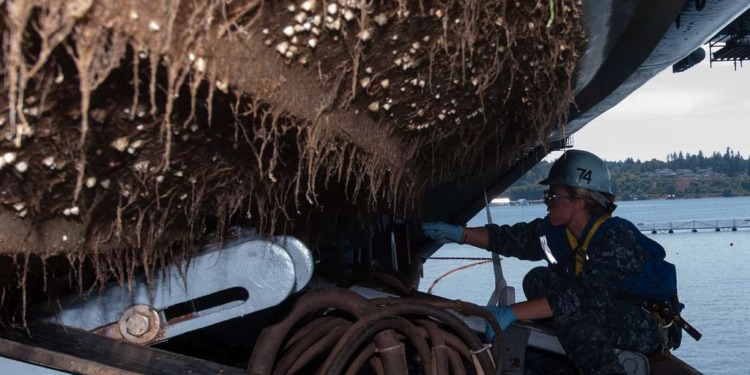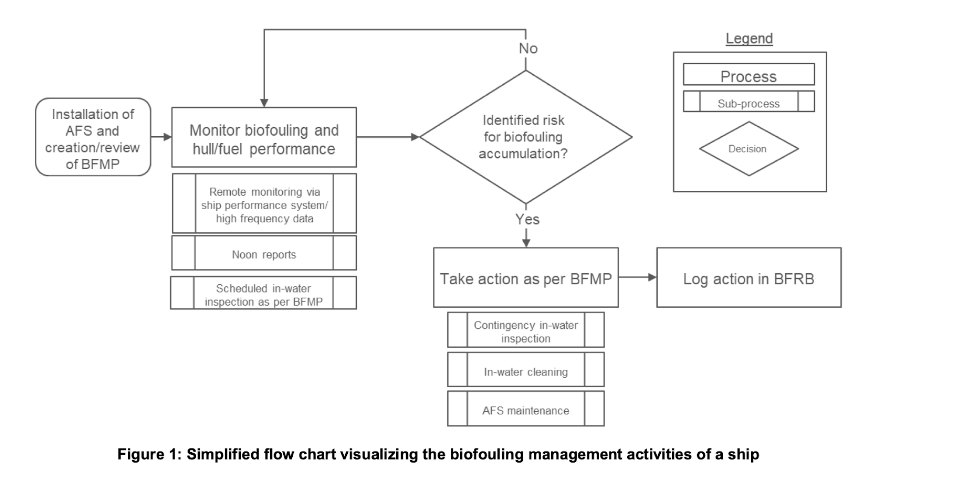Maritime shipping is responsible for about 10% of transportation-related emissions yet the industry continues to grow with record high global emissions. In this context, the International Maritime Organization (IMO) has set up policies striving for a carbon-neutral industry that still has a long way to go. Neptune Robotics, an AI tech startup founded in 2018, is part of this greater endeavor to pave a sustainable future for the industry focusing on where we would have never imagined: the hull or underside of ships.
Here is why: Biofouling, caused by marine organisms such as algae, seaweed, barnacles, and other organisms that attach themselves to hulls, slows ships down and reduces fuel efficiency — it can cause up to a 20% increase in fuel consumption. The IMO also reported that just 1% of biofouling is responsible for an additional 1% of global emissions.
With this in mind, Neptune Robotics aims to cut carbon emissions and fuel use by targeting the global fleet of container ships, bulk carriers, and tankers with their robots.“This isn’t just about efficiency. It’s about protecting our oceans, reducing fuel consumption and emissions, and contributing to a cleaner planet,” said Elizabeth Chan, the startup’s CEO.
Based in China, the Neptune Robotics team is still growing and its headcount hit 120 last year. The team comprises industrial engineers, AI researchers, robotic inventors, and product designers. With the growth of their operations, Neptune Robotics looked for funding to continue operations. And in 2022, they raised USD 17.25 million in Series A funding. They are backed by major venture investors including Sequoia Capital, Matrix Partners, and SOSV. “We are going to extend Neptune’s robotic offerings, expand into more ports and increase the fuel efficiency of our customers in an environmental manner,” stated Chan after the funding.
Neptune Robotics prides itself on cutting-edge cavitational technology, i.e., harnessing the power of vapor bubbles in a fluid to generate precisely directed shockwaves, with robotic routes powered by AI algorithms. As their website indicates, they aim “to achieve Net Zero before 2050 through the use of AI and robotics, reducing maritime fuel consumption and carbon emissions.” An audacious goal, but backed by a track record of activities in the ports of the world’s largest trading country, China.
With 27 robots in operation and a new one added every week, on average, Neptune Robotics is present in over 50 ports and anchorages, and they have serviced over 600 large vessels.
China continues to be the focus of their operations but, with the funds they have raised, they now plan to grow a larger footprint in Asia, starting in Singapore, followed by Europe and the U.S. Other competitors exist, like Hullbot, a Sydney-based startup, yet, as of now, it appears that Neptune Robotics has a big advantage due to its extensive presence in major ports throughout China.
What exactly is biofouling and why is it so damaging?
A biofouling layer as thin as a human fingernail can cover half a ship’s hull. It can trigger an increase in greenhouse gas (GHG) emissions by 20 to 25%, according to a 2022 study co-authored by the IMO.
Furthermore, biofouling can harbor invasive species, potentially disrupting marine ecosystems. Barnacles are one of the main enemies when cleaning ships, their reputation as the most feared biofouling agent precedes them. Firmly attaching themselves to the bottom of the ship’s hull, they generate thousands of larvae with each cycle. This results in even more drag, vessel resistance, and reduced speed.
The robots provide fast and seamless cleaning for the bottom of the vessels thanks to:
- Cutting-edge waterjet technology that protects vessel paint, ensuring optimal cleaning;
- adhesion technology that ensures effective cleaning, whether the vessel is fully discharged or loaded
As a result, robots can clean the hull of a large container ship in less than four hours, compared to eight hours or more using traditional methods, such as manual cleaning by divers.
Robots can always operate regardless of weather and water conditions, even in the murkiest waters or in extreme weather, but they do need an onsite team to oversee operations. “While in service, there is a Neptune operation team of four on site,” says Chan. “We expect to reduce it to one for port operations and two for anchorage operations.”
Related Articles: How Commercial Flights Could Go Electric | What’s Next in Geothermal Energy? |How Automated Robots Are Transforming Manufacturing Processes | Food Tech: Are 3D-Printed Food and Meatless Meat the Future?
How biofouling control is a key component in the IMO strategy for reducing ships’ carbon emissions
The IMO has set up plans to achieve net zero emissions by 2050 working closely with the whole shipping industry. Also, it is intensifying efforts to reduce greenhouse gas emissions from ships with fuel strategies, including the development of alternative fuels like Ammonia, Ethanol, and Hydrogen.
In 2023 the Port of Los Angeles obtained a governmental grant of up to $1.2 Billion to help power the fuel transition. “We’ll use this grant to support the purchase of hydrogen fuel cell-powered equipment throughout the port complex. We are excited about the transformation that hydrogen will play in our zero-emission future” said Gene Seroka, Executive Director of the Port, showcasing the pioneering effort in green technology adoption within the industry.
With fuel use being a primary source of maritime emissions, any reduction in fuel consumption through better hull maintenance can have a significant impact on a ship’s carbon footprint. Even the alternative fuel improvements can be compromised by inefficient hull conditions due to biofouling. Advanced biofouling management strategies, such as the use of specialized anti-fouling coatings and regular hull cleanings, are crucial.
With the IMO spurring more stringent standard regulations, maritime cleaning robotics is expected to play a key role in turning shipping into a sustainable industry worldwide. Involving a shift towards advanced, autonomous solutions, it is driven by the need for more efficient, environmentally friendly vessel maintenance practices.
In the competitive space of robot cleaning solutions, Neptune Robotics continues to distinguish itself amidst rivals such as Hullbot. Where technology and strategies set them apart. Specifically, Hullbot focuses on a proprietary vision system compared to Neptune’s integration of artificial intelligence and robotics. Additionally, outlining their advanced capability to operate effectively in challenging environments and their sophisticated data analytics to provide actionable insights into hull maintenance. This dual approach aligns closely with evolving IMO regulations, positioning Neptune as a key player in efforts to decrease the environmental impact of shipping.
Overall, the ships are seeing the benefits unlocked by robots with reducing fuel consumption, drag, and resistance. Nonetheless, this will not be the only way the industry will achieve net zero by 2050. As the robots are only a significant step along the way, there is still a lot of work to overcome all the challenges for a sustainable maritime industry.
Editor’s Note: The opinions expressed here by the authors are their own, not those of Impakter.com — Cover Photo Credit: Getarchive.










